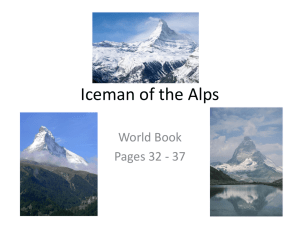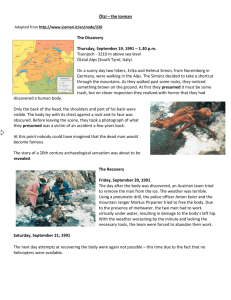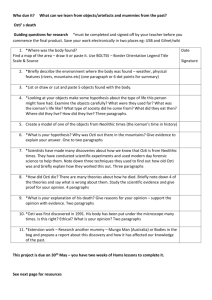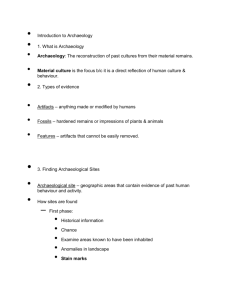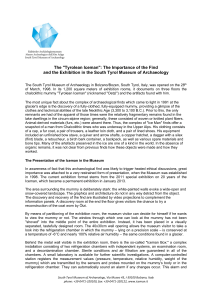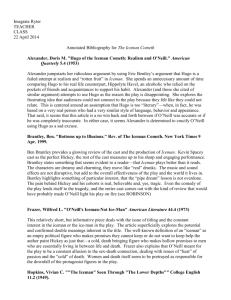Archaeology Research Project
advertisement
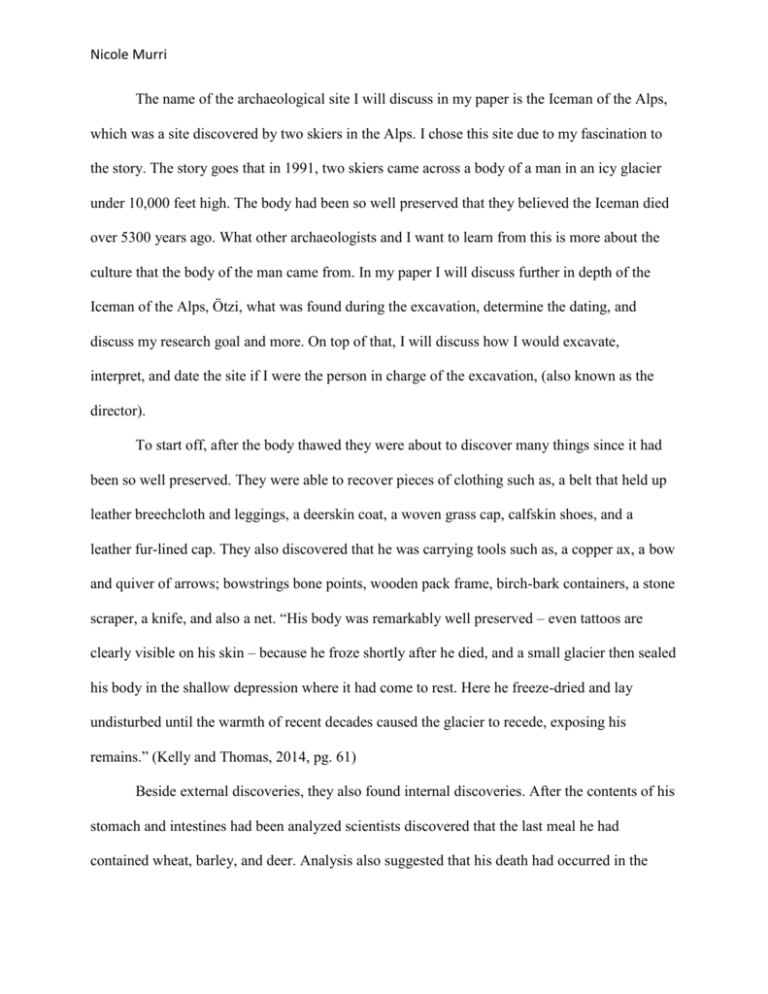
Nicole Murri The name of the archaeological site I will discuss in my paper is the Iceman of the Alps, which was a site discovered by two skiers in the Alps. I chose this site due to my fascination to the story. The story goes that in 1991, two skiers came across a body of a man in an icy glacier under 10,000 feet high. The body had been so well preserved that they believed the Iceman died over 5300 years ago. What other archaeologists and I want to learn from this is more about the culture that the body of the man came from. In my paper I will discuss further in depth of the Iceman of the Alps, Ötzi, what was found during the excavation, determine the dating, and discuss my research goal and more. On top of that, I will discuss how I would excavate, interpret, and date the site if I were the person in charge of the excavation, (also known as the director). To start off, after the body thawed they were about to discover many things since it had been so well preserved. They were able to recover pieces of clothing such as, a belt that held up leather breechcloth and leggings, a deerskin coat, a woven grass cap, calfskin shoes, and a leather fur-lined cap. They also discovered that he was carrying tools such as, a copper ax, a bow and quiver of arrows; bowstrings bone points, wooden pack frame, birch-bark containers, a stone scraper, a knife, and also a net. “His body was remarkably well preserved – even tattoos are clearly visible on his skin – because he froze shortly after he died, and a small glacier then sealed his body in the shallow depression where it had come to rest. Here he freeze-dried and lay undisturbed until the warmth of recent decades caused the glacier to recede, exposing his remains.” (Kelly and Thomas, 2014, pg. 61) Beside external discoveries, they also found internal discoveries. After the contents of his stomach and intestines had been analyzed scientists discovered that the last meal he had contained wheat, barley, and deer. Analysis also suggested that his death had occurred in the Nicole Murri spring. The DNA analysis was able to suggest that he was lactose intolerant, had brown eyes, had O type blood, and also carried Lyme disease. Researchers were puzzled to find that he had died at a high elevation, higher than where his village or living place would have been. They found that an arrow blade was lodged in his shoulder blade and on his hands were cuts that were unhealed and untreated, suggesting that he had been attacked from another bearing a knife, after he might have fled and laid to rest but never woke up due to his wounds. (Kelly and Thomas, 2014, pg. 61) Based on what was found on the body and about the body, what might that determine about the culture or civilization that he lived in? It definitely suggests that they would have been hunters and gatherers since he carried weapons, his stomach also contained remnants of deer. Also they would have been gatherers, or there could also be the possibility of agriculture, since his stomach and intestines contained wheat and barley. He also carried Lyme’s disease which is found in ticks, which also comes from exploration and wandering, and also gives a hint to the type of surroundings he lived in. Based on what was determined by culture they are able to determine the date and the changing over time. The culture may have changed through the strata or periods, but due to well preserved evidence, they were only able to determine what their culture was like for that given period of time. Archaeologists were able to determine the dating of the site by absolute dating, since they were able to determine that the Ice Man died 5300 years ago, they are able to get an estimated calendar date. (Spindler, Konrad) In contribution to dating and culture also comes the process of excavating. Robert Clark of National Geographic states, “Although long periods of fine weather in 1992 had melted much of the snow, large quantities of snow in the crevices between the blocks of stone had to be Nicole Murri melted using steam jets and hot-air blowers.” (James, Robert) In contribution to the topic of excavating there was also surveying. The first archaeological survey of the scene where the Iceman was discovered was carried out between October 3 and 5, 1991. Its aim was to document the exact position of the body and the rest of the finds by detailed contour plan. However, the winter put an end to further archaeological investigations that year. Between July 20 and August 25, 1992, a second archaeological survey was carried out by several institutes under the direction of the Ancient Monuments Office of the autonomous province of Bolzano. (The South Tyrol Museum of Archaeology) With all the information presented how does this relate to my research goal? The evidence found from the excavation and the body relates directly to my research goal, it shows that they lived together, it shows the way they lived, and it also determines the period that they lived in and their area of living. There is plenty of evidence to make a hypothesis and use the scientific method to better excavate the area of living to prove more information about the culture. The South Tyrol Museum of Archaeology was able to determine, “Based on scant Copper Age finds discovered in what is today South Tyrol, and everything indicates that Ötzi was a member of the first independent Alpine cultural group, Tamins-Carasso-Isera 5.” (The South Tyrol Museum of Archaeology) Next, I will discuss how I would excavate, interpret, and date the site, The Iceman of the Alps, if I were the person in charge of the excavation, (also known as the director). The original director of the Iceman, after finding the block of ice, thawed the body and transferred the body to a custom-made box lined with sterilized aluminum foil. Immediately they began an autopsy hoping to shed light on the mystery. (Hall, Stephen) Each step they took they did very carefully and done with precise thought. I wouldn’t have done anything differently in the matter of Nicole Murri excavation. After the surgery of the stomach, as mentioned before, they found wheat, barley, and deer. From this there can only come inferences, and using the scientific method I could hypothesize that he could have been a gatherer, or there could also be the possibility of agriculture, and then I would follow the steps and come to a solid conclusion. I could also do the same to figure out the culture and lifestyle of the Iceman of the Alps. Using the surrounding areas and the information provided I could also do the same with dating the site. Using the area Otzi was found and using the information found from the body would be a huge step to making an inference or interpretation of excavating, interpreting and dating the site. As a conclusion, due to the frozen decaying process most of the body was able to be preserved and answers many questions raised by archaeologists and anthropologists. I talked about what was found during the excavation, determining the dating, discussed my research goal and on top of that, I discussed how I would excavate, interpret, and date the site if I were the person in charge of the excavation. From my information I stated that they were able to determine what he would have looked like, what the culture would have been like, answering my research goal and uncovered the mysteries of the exciting and intriguing stories of the Iceman of the Alps. Nicole Murri Works Cited "Excavations in the Ice." Iceman. SOUTH TYROL MUSEUM OF ARCHAEOLOGY, 2013. Web. 29 Sept. 2015. Hall, Stephen S. "Iceman Autopsy." NGM. NGS, Nov. 2011. Web. 18 Nov. 2015. Iceman, Wolfgang Müller et al, Science, 31 October, 2003. Kelly, Robert L., and David Hurst. Thomas. Archaeology: Down to Earth. Belmont, CA: Wadsworth, Cengage Learning, 2014. N. pag. Print. Owen, James. "5 Surprising Facts About Otzi the Iceman." National Geographic. National Geographic Society, 18 Oct. 2013. Web. 29 Sept. 2015. Spindler, Konrad. "Iceman." Iceman. AU, 2015. Web. 18 Nov. 2015.
